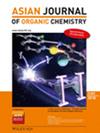Visible‐Light Mediated, Photocatalyst‐Free C−S Bond Formation via EDA Complex Formation
IF 2.8
4区 化学
Q1 CHEMISTRY, ORGANIC
引用次数: 0
Abstract
The presence of sulphur groups in the structures of many natural products and therapeutic candidates makes sulfur‐containing molecules indispensable. In organic chemistry, the study of carbon‐sulfur (C−S) bond formation via electron donor‐acceptor (EDA) complexes is a dynamic and developing field. EDA complexes facilitate a variety of chemical transformations, including the production of C−S bonds, by interacting between an electron‐rich donor and an electron‐deficient acceptor. In this review, we focus on the literature reports on formation of electron donor‐acceptor complex (EDA) between appropriate starting materials. Some new research investigates the use of light to stimulate C−S bond formation using EDA complexes. Photo‐redox catalysis is a promising field in which substrates can be activated under gentler circumstances. In this review, we have highlighted the photoactivation of the EDA complex and an intermediate formed in the reaction itself. We classified the collection of the journal under the following headings such as one pot ring annulation and cyclization involving C−S bond formation, C−S bond formation by dehalogenation, C−S bond formation in multicomponent reaction, C−S bond formation by leaving group, C−S bond formation on alkene/alkyne and other miscellaneous.

求助全文
约1分钟内获得全文
求助全文
来源期刊

Asian Journal of Organic Chemistry
CHEMISTRY, ORGANIC-
CiteScore
4.70
自引率
3.70%
发文量
372
期刊介绍:
Organic chemistry is the fundamental science that stands at the heart of chemistry, biology, and materials science. Research in these areas is vigorous and truly international, with three major regions making almost equal contributions: America, Europe and Asia. Asia now has its own top international organic chemistry journal—the Asian Journal of Organic Chemistry (AsianJOC)
The AsianJOC is designed to be a top-ranked international research journal and publishes primary research as well as critical secondary information from authors across the world. The journal covers organic chemistry in its entirety. Authors and readers come from academia, the chemical industry, and government laboratories.
 求助内容:
求助内容: 应助结果提醒方式:
应助结果提醒方式:


